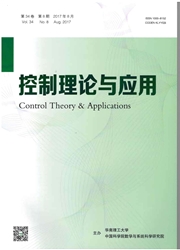

 中文摘要:
中文摘要:
在基于证据理论的信息融合故障诊断方法中,诊断证据的可靠性高低将会直接影响诊断结果的准确性.而现有的大多数方法并没有全面地评估证据的可靠性,从而常常导致融合诊断结果的不准确.决定证据可靠性的因素主要有传感器的精度与证据获取方法的性能,以及传感器运行环境中的不确定性因素,可将它们分别理解为静态和动态因素.本文利用基于Pignisti。的指标函数优化算法获得静态折扣因子,用其对原证据进行修正;接着提出基于Pignistic向量的证据相似度度量方法获取动态折扣因子,用其对证据进行再次修正,并利用Dempster组合规则融合经两次修正后的证据,得到诊断结果.最后,通过在多功能柔性转子试验台上的实验,验证了所提方法的有效性.
 英文摘要:
英文摘要:
In fault diagnosis methods based on evidence theory with information fusion, the reliabilities of evidences will affect the accuracy of diagnosis results. However, most existing fusion diagnosis methods do not take the reliabilities of the evidences into account comprehensively. The main factors which determine the reliability of evidence are the precision of individual sensor and the performance of the method in obtaining the evidence, as well as the uncertainties in the observation environment. They are considered static factors and dynamic factors. The original evidence is first modified by a static discount-factor obtained by optimizing the indication function of Pignistic probability measure. This result is further modified by a dynamic discount-factor which is obtained by applying the measurement method to evidence similarity in Pignistic vectors. Double-modified evidences are combined by Dempster combination rule to obtain the final diagnosis results. Experiments on the multi-functional flexible rotor-testing validate the effectiveness of the proposed method.
 同期刊论文项目
同期刊论文项目
 同项目期刊论文
同项目期刊论文
 Representation of Uncertain Multichannel Digital Signal Spaces and Study of Pattern Recognition Base
Representation of Uncertain Multichannel Digital Signal Spaces and Study of Pattern Recognition Base Risk analysis of E-commerce project development based on fuzzy set theory and analytic hierarchy pro
Risk analysis of E-commerce project development based on fuzzy set theory and analytic hierarchy pro Representation of uncertain multi-channel digital signal spaces and study of pattern recognition bas
Representation of uncertain multi-channel digital signal spaces and study of pattern recognition bas DELAY-DEPENDENT STABILITY CRITERION AND H infinity STATE-FEEDBACK CONTROL FOR UNCERTAIN DISCRETE-TIM
DELAY-DEPENDENT STABILITY CRITERION AND H infinity STATE-FEEDBACK CONTROL FOR UNCERTAIN DISCRETE-TIM Delay-dependent global robust stability criterion for neural networks with neutral-type time-varying
Delay-dependent global robust stability criterion for neural networks with neutral-type time-varying Similarity Relation of Two-Dimensional Frustum Pyramid Fuzzy Numbers Based on the Geometry and Its A
Similarity Relation of Two-Dimensional Frustum Pyramid Fuzzy Numbers Based on the Geometry and Its A Brief Paper Improved exponential stability criteria and stabilisation of T-S model-based neutral sys
Brief Paper Improved exponential stability criteria and stabilisation of T-S model-based neutral sys Distributed Kalman filtering fusion with packet loss or intermittent communications from local estim
Distributed Kalman filtering fusion with packet loss or intermittent communications from local estim Constructing n-cell numbers by using double-side separation degrees and pattern recognition based on
Constructing n-cell numbers by using double-side separation degrees and pattern recognition based on Uniqueness and Explosion Time of Solutions of Stochastic Differential Equations Driven by Fractional
Uniqueness and Explosion Time of Solutions of Stochastic Differential Equations Driven by Fractional 期刊信息
期刊信息
